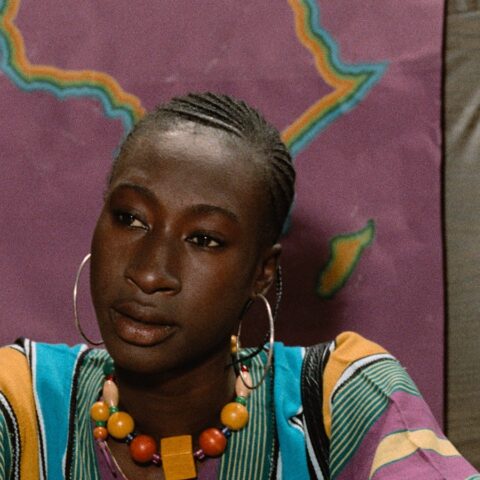From Metaphor to Mythic Language: A Review of Echezonachukwu Nduka’s Chrysanthemums for Wide-eyed GhostsBy Daniel ChukwuemekaThursday, June 27, 2019.Mother taught me that a song can healthe worst of diseases, but she didn’tmention that songs can kill too.Echezonachukwu Nduka, “Bambari VII”Poetry is philosophy in literary form; and literary analysis is an exercise in critical thinking. Yet unlike the subject of philosophy itself, poetry does not ask fundamental life questions with the aim of attempting lucid explanations. This “deliberate ordering of thought…encapsulating meaning and feeling” is philosophical inasmuch as the questions and findings it yields deserve, following Aristotle, serious attention.If we are to embrace William Wordsworth’s example, we can say that Echezonachukwu Nduka’s poetic offering is an imaginative expression of strong feelings, sometimes rhythmical, emanating from a spontaneous overflow of powerful emotions, recollected in tranquillity. But the poetic enterprise and the effort in writing is a labour requiring the intersection of public and private experience, tradition and individual talent. It is for this reason that we can also find, in Chrysanthemums for Wide-eyed Ghosts, “What often was thought but never so well-expressed.” This intersection of public and private experience renders difficult the possibility of emergence of a reducible meaning and interpretation. Instead, what we have are findings, accidental encounters with language through close reading, encounters which promise to yield fresh understandings when subjected to other forms of reading and analysis.There is no excitement in poetry (except by excitement one refers to an epiphanic moment of bumping into a string of words that offer or promises to offer fresh insight after critical evaluation of parts or all of the composition). Rather, what obtains in poetry is an exertion of the mind to think, and think again; again and again; and, in doing so, to pay attention to the seriousness of that thought and the process by which it is formulated.Reading through this debut collection was an invitation to think repeatedly, and in quick succession, about the significance of thoughts so artistically expressed, yet thoughts which betrayed the fringes of privacy from which they resonated to the public space. Hence, when one encounters such a line as “Rap music is for the living, but concertos and canticles are for / cemetery / citizens who maintain the road that leads to heaven,” (37) one’s major senses will be activated to visualise the procession from life to death in a theatrical display governed, directed and accompanied by the feel of music; the transition from young to old, from vibrancy to torpidity; and to ultimately attempt to make meaning of the significance of the difference in the sounds as they hit the auditory canal—all of which are parts of the general human experience.Echezonachukwu Nduka’s poems constitute a lyrical homage to the continuity of life after death (not in its ritual sense, though) as exemplified by the alertness of human spirits (ghost) whose activities are portrayed to be in entanglement with the banality of everyday life in various degrees: hopes, impediments, emptiness and resolve to thrive. Thus wreaths remind the persona in “Living Near St. Vincent De Paul Cemetery” of “death’s beauty” (37) because such oxymoronic plane is one on which the complication of life and death, the living and the dead, flourish.After reading “Inside the Old Room” for what seemed like the umpteenth time, one begins to see the fading light of private experience that must have yielded the thought of the impact of one’s muted past life—“Grandpa’s chair bears forbidden histories / from his weight” (5). Yet, considering the sensitivity of “stories of a war that ate many souls” and stories of “his lost guns” (5), one would easily be transported to the Grandpa’s personal trauma (his inability to light “oil-lamps,” to play “the role of God,” in his dying days) as a first step towards evaluating the extent to which the sense of loss and emptiness that his life exemplifies helps to explain life and living as a “sting of departures” (5).I conceive of Echezonachukwu Nduka’s masterpiece as hermetic poetry: sometimes obscure and difficult, in the highly symbolic mould of Soyinkanism, it is a site where subjective language and imagery intersect, with the sound of words as suggestive as the words’ deliberate ordering. The referent in “You Are Not a Stranger” is disturbingly closed up (“You swallowed your words and sent signs,” 15); yet the persona insists that they left with his world and, which is, more importantly, his voice—“…you left with my world / You left with a voice that I’d never find” (15). In what way do we possibly make sense of how a thoroughly voiceless fellow could bottle up the “voice” of the persona if not by some mythic ideation?For Seamus Heaney, just as DNA is the genetic code for the human body, so is myth the poetic code for the human spirit. And by myth Heaney meant specifically any imaginative work that consciously or unconsciously takes on an identifiably mythic shape, such as through language. Elsewhere, I have contended that poetry is “an emergence of a playfield of metaphor which tasks the mind to appreciate and reflect upon the subtlety of artistic language.” But with this collection, poetic reflection goes beyond metaphor to wrestle with mythic language—one that “projects the nuances of our own psyche rather than limiting us to what the poet, or ourselves, can verbalize” (Lynne Milum). In literary writing, the deployment of mythic language is equivalent to the absence of immediacy—a derivative form of reader-response. Poetry of mythic language therefore tasks the mind to look beyond its metaphor for meaning and, more than that, see meaning as the object being studied.Take “Love Is Death,” for example: Dry petals, broken filaments and anthers Make mockery of my balcony, These frowning flowers tell poignant tales, On Val’s eve, they bloomed. Their scents wafted Beyond my rooftops as love; now, death is theirs and on me, They also beckon. Death hides its face in love’s lyrics As these songs melt my heart; I follow The tides and crash in the arms of death, This love is death; I’m free from its embrace. (1—10)We have metaphors expressed in oxymoron, which leave us with an understanding of the paradoxical nature of love as death: “Dry petals,” “frowning flowers.” So our primary interest no longer lies in the movement of metaphor more than it does in the meaning it confronts. Where the meaning is dialectical, as a consequence of its mythic language, it is intransitive, and thus problematic. One has to think over and over again about the significance of the deadly nature of love; and more so about what it means to be free from an embrace in which one has hitherto been enveloped, and whether this freedom longed for is going to be a sort of disentanglement from love or from death. A reading of “This Night That Knows No Sleep” also suggests similar configuration of dialectics where the “night’s mystery of wakefulness” (81) spins a web of unresolved questions about death, nature and the role of the God factor in these things.Overall, Nduka’s collection, in its subjective reflections on life, death and continuity, and their intersection with songs of yearning and everyday living, leaves us with rich poetic wreaths of tribute (chrysanthemums) to the dead (the unfathomable, intangible nature), and which invariably constitute a eulogy in commemoration of their ever-present complexities expressed in relation to the fears and inexperienced overtures (hence the wide-eyed ghosts) of the living.Daniel Chukwuemeka is a scholar and a doctoral student at the University of Bristol, UK. He is originally from Nigeria.
A Review of Echezonachukwu Nduka’s “Chrysanthemums for Wide-eyed Ghosts”
No Comments currently posted | Add Comment
Comment on this Article
Your Name
Please provide your name
Your Comment
//set data for hoidden fields
//transfer();
var viewMode = 1 ;
//============================================================================
//HTML Editor Scripts follow
//============================================================================
function exCom(target,CommandID,status,value)
{
document.getElementById(target).focus();
document.execCommand(CommandID,status,value);
}
function transfer()
{
var HTMLcnt = document.getElementById(“ctl00_MainContent_txtComment_msgDiv1”).innerHTML;
var cnt = document.getElementById(“ctl00_MainContent_txtComment_msgDiv1”).innerText;
var HTMLtarget = document.getElementById(“ctl00_MainContent_txtComment_HTMLtxtMsg”)
var target = document.getElementById(“ctl00_MainContent_txtComment_txtMsg”)
HTMLtarget.value = HTMLcnt;
target.value = cnt;
}
function hidePDIECLayers(f,p)
{
//e.style.display = ‘none’
f.style.display = ‘none’
p.style.display = ‘none’
}
function toggle(e)
{
if (e.style.display == “none”)
{
e.style.display = “”;
}
else
{
e.style.display = “none”;
}
}
function ToggleView()
{
var msgDiv = document.getElementById(“ctl00_MainContent_txtComment_msgDiv1″);
if(viewMode == 1)
{
iHTML = msgDiv.innerHTML;
msgDiv.innerText = iHTML;
//alert(viewMode);
// Hide all controls
Buttons.style.display = ‘none’;
//selFont.style.display = ‘none’;
//selSize.style.display = ‘none’;
msgDiv.focus();
viewMode = 2; // Code
}
else
{
iText = msgDiv.innerText;
msgDiv.innerHTML = iText;
// Show all controls
Buttons.style.display = ‘inline’;
//selFont.style.display = ‘inline’;
//selSize.style.display = ‘inline’;
msgDiv.focus();
viewMode = 1; // WYSIWYG
}
}
function selOn(ctrl)
{
ctrl.style.borderColor = ‘#000000’;
ctrl.style.backgroundColor = ‘#ffffcc’;
ctrl.style.cursor = ‘hand’;
}
function selOff(ctrl)
{
ctrl.style.borderColor = ‘#9BC1DF’;
ctrl.style.backgroundColor = ”;
}
function selDown(ctrl)
{
ctrl.style.backgroundColor = ‘#8492B5’;
}
function selUp(ctrl)
{
ctrl.style.backgroundColor = ‘#B5BED6’;
}
�
Size 1
Size 2
Size 3
Size 4
Size 5
Size 6
Size 7
//give focus to the msgdiv… always otherwise save button will not save content.
var mDiv = document.getElementById(“ctl00_MainContent_txtComment_msgDiv1”);
try
{ mDiv.focus();}
catch(e)
{
//alert(‘Invisible’)
}
//if ( <> ‘none’)
//
Send to a friend | �
View/Hide Comments (0) | �




Зарегистрируйтесь прямо сейчас и получите 100 фриспинов без депозита, чтобы испытать свою удачу в увлекательных играх и повысить свои шансы на крупный выигрыш. рейтинг казино онлайн ivfiojtgwn …